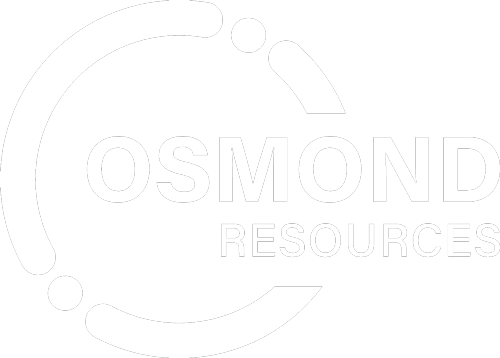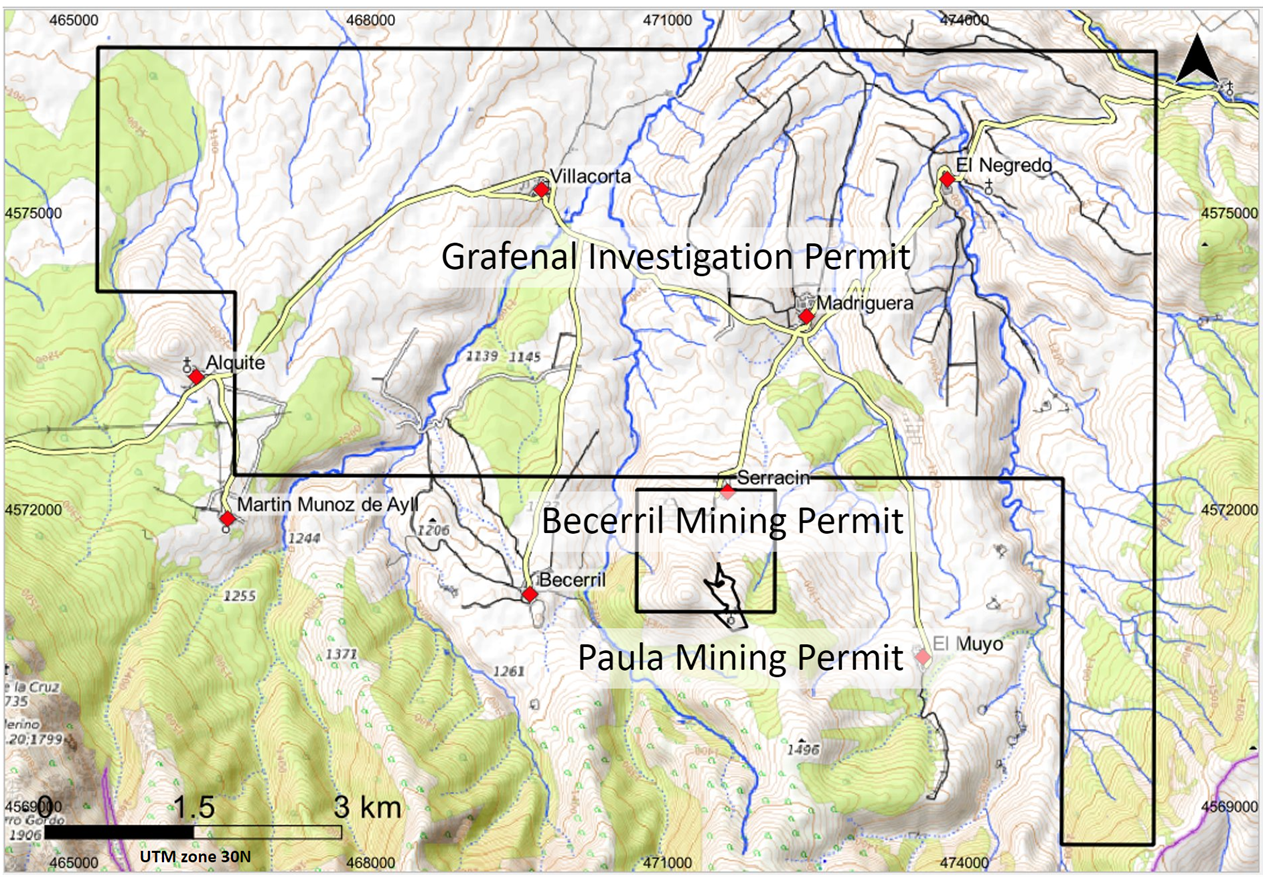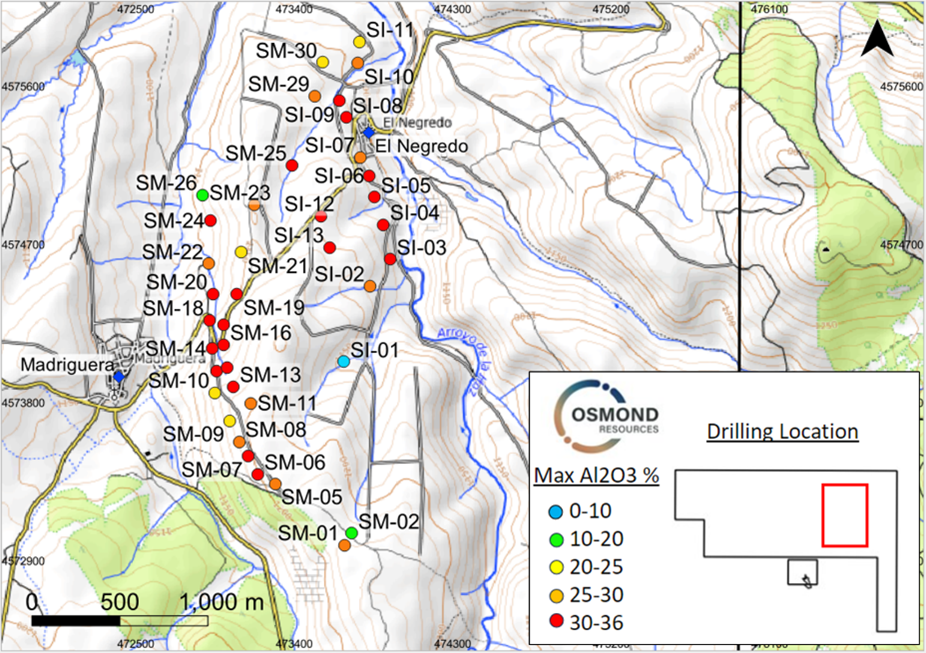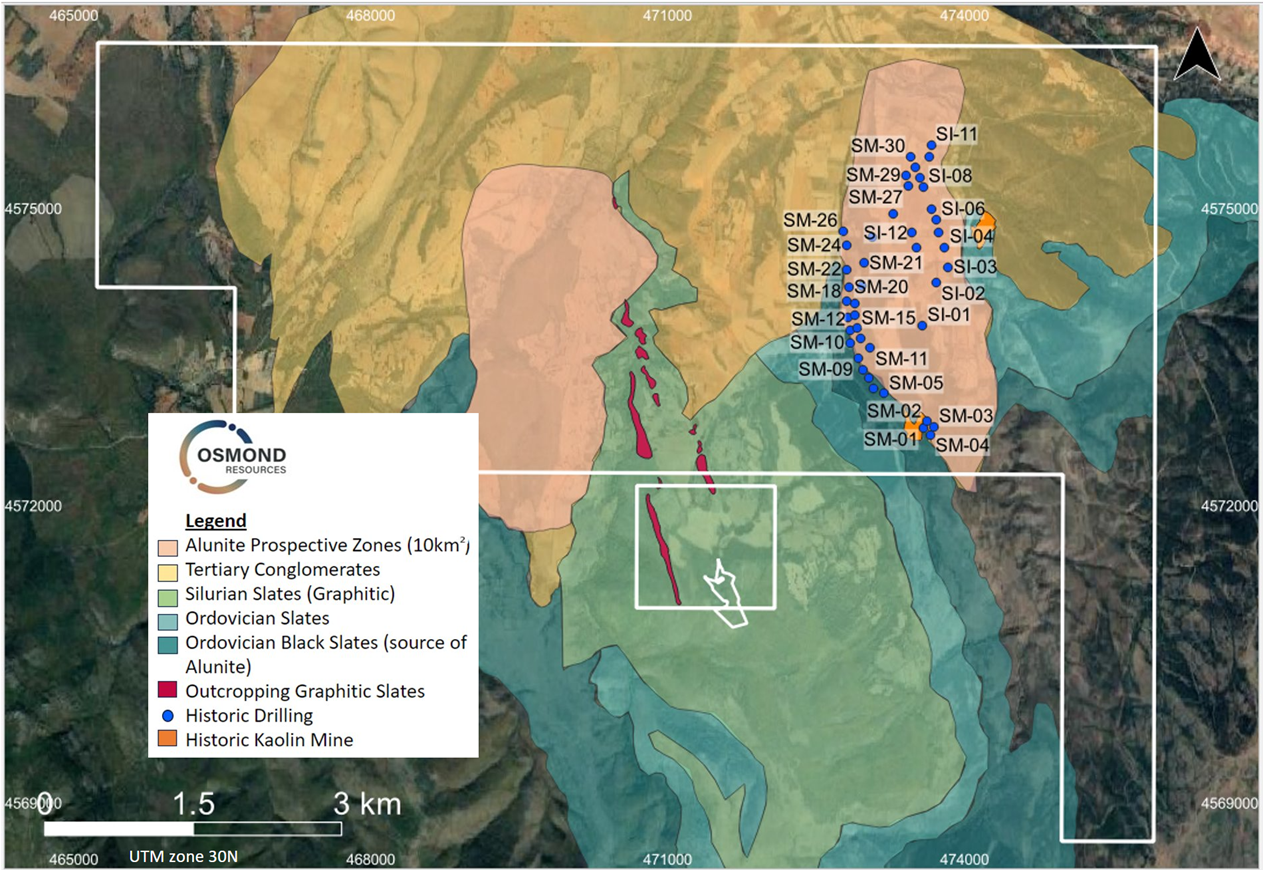The Iberian One Project is located in a historic kaolin, iron and graphite mining district between the villages of Madriguera and El Negredo in the Segovia Province, Spain, located approximately 100km NNW of the major city of Madrid (Figure 1).
The project consists of the Grafenal Investigation Lease (47.5km2), the Becerril Mining Permit (1.6km2) and the overlapping Paula Mining Permit, together totalling approximately 50km2 as the Iberian One Project Area.
Access to the Project area is well serviced by the many roads throughout area. The topography of the areas is largely rolling hills. The main land use in the area is mixed agriculture and forestry (Figures 3A and 3B). There is evidence of historic mining operations within the project area, with kaolin mines and a historic small processing plant (Figure 4).
Exploration in 1964 by the Institute of Geology and Minerals Spain (IGME, Spanish Geological Survey) found that associated with the kaolin in the area the mineral alunite also existed. This was followed up by additional exploration in the early 1970s, targeting the potential for producing aluminium from the alunite. Alunite is a mix of aluminium and potassium sulphate.
Alunite mineralisation had been identified in the existing historical kaolin mines within the Project area. The origin of the alunite mineralisation is thought to be related to the weathering of black (sericite-graphitic) slates, probably linked to breaking down of sulphur present in the slates. The result of the weathering is the production of a kaolinite and alunite mineralised weathering profile sitting at approximately 30 to 50 meters depth and overlying the graphitic slates.
The focus of the 1970’s exploration by the IGME over the alunite occurrences at Madriguera and El Negredo (both within the Project area Figures 5 and 6) was on the aluminium resource potential of the alunite and additionally the kaolinite occurrences, with little focus on the SOP potential.
However, due to the increasing global demand for SOP as an important and high-value component in fertiliser, the Iberian One Project is seen potentially as a strategically and economically important source for SOP, there is also potential for aluminium and sulphuric acid as a byproduct from the production of SOP.
Osmond is attracted to the Iberian One Project for the potential to produce a range of products from the alunite – kaolin mineralisation and the graphite potential.
Main target product to be investigated is defining alunite mineralisation that can potentially feed into the production of Sulphate of Potash (SOP) – a premium fertiliser product. Other secondary targets are:
- Alum (aluminium potassium sulphate) – used in a range of industries including in water purification;
- Kaolinite – an industrial mineral used in a wide range of industries including ceramics, cement and paint industries;
- Graphite – a critical mineral in the decarbonisation of the global economy.
Historical Exploration
Mining activity in the region traces back to artisanal mining for iron ore in the Middle Ages and small-scale graphite extraction in the 19th and 20th centuries. Then in 1964 the Institute of Geology and Minerals Spain (IGME), which serves as the national geological service, undertook a sampling program across artisanal kaolin pits in the area, collecting samples and conducting field reconnaissance mapping. The samples were chemically and X-ray analysed and it was found that the kaolin also included occurrences of alunite mineralisation. A period of exploration and small-scale production of kaolin was undertaken in the late 1960’s and early 1970’s by the private company, Mina Pilar S.A.
In 1973, due to the poor bauxite resources in Spain, the Government of the time commenced exploration for alunite as a potential source of aluminium, and the project area was included in the National Mining Investigation Plan. In January 1973, the kaolin and alunite deposits were declared a “Provisional Reserve” by the Government for aluminium ore. In April of that year the Government approved the Investigation Project for the area.
The Government exploration included geological mapping and geophysics (SEV – Sondeos Eléctricos Verticales or Vertical Electrical Surveys). In January 1974 to April 1975 two drilling programs were completed for a total of 43 holes and a total of 2,584.85m was conducted across the project area, with drill hole depths between 50-75m.
The focus of the 1970’s exploration by the IGME over the alunite occurrences at Madriguera and El Negredo (both within the Project area Figures 5 and 6) was on the aluminium potential of the alunite while also identifying kaolinite occurrences, with little focus on the SOP potential.
In the early 1980´s, public company AUXINI investigated the alunite of Riaza, establishing a pilot plant, as part of a project of metallurgical assays of different aluminium ores of Spain.
In addition, Osmond are aware of another 150 holes in the region, including many drill holes within the Iberian One Project area, which expands on the historical information. However, Osmond is still in the process of locating detailed historical documents from the government departments, through the vendors of the project.
Historical drilling across the deposit has identified large areas of both alunite and graphite potential (Figures 5 and 6) with peak grades from historical drilling including:
- 3.7m at 37.21% Al2O3 from 34m in SI-3
- 0.2m at 36.1% SO3 from 55.5m in SI-9
- 3.3m at 19.93% SO3 from 42m in SI-10
- 11.3m at 4.8% K2O from 38.7m in SI-3
- 8.1m @ 21.62% Carbon 32.5m to 40.6m SM-26
Project Geology
The origin of the mineralisation is related to alteration processes of black slates, probably linked to weathering in wet climate conditions. This enrichment in aluminium, from sericite-graphite slates, possibly with pyrophyllite, is followed by a stage of edaphic and / or diagenetic alteration of probable tertiary age, fossilised by the alluvial materials of the Miocene. The alunite and kaolin mineralisation forms within the horizon of tertiary alteration in the Upper Ordovician slates.
In the project area, the Palaeozoic outcrop consists of Ordovician (slates and quartzites), Silurian (fundamentally slate) and Devonian (limestone) units. They are partly covered by Tertiary detrital materials, which in turn are partially covered by Pliocene-Quaternary materials. Mesozoic sediments, represented by Triassic, Jurassic and Cretaceous sequence are located towards the east of the project area.
The Ordovician and Silurian slates are very aluminous, poorly recrystallised and contain abundant carbonaceous graphite and frequent pyrite in nodules or disseminated; it almost always appears in somewhat oxidized forms.
The Mesozoic is represented by a Triassic detritus and limestone, the Jurassic is represented by a dolomite and the Cretaceous is represented as a detrital and calcareous-dolomite.
The sedimentological evolution of the Tertiary materials is likely to be the following:
- Formation of detrital sediments in the lower Tertiary with facies of polygenic conglomerates around Santibáñez in depressed areas, where the “basement” would be constituted by Paleozoic slate-quartzite materials and Mesozoic limestones.
- Uplifting of Somosierra Range controlled by large fractures, which originates a mother area of detrital sediments carried on by the continental waters towards the NW and N. Intensive localised rainfalls form alluvial fans with deposition of large conglomerate “Rañas” (Villacorta) and at the same time erosion of the oldest materials: Paleozoic, Mesozoic and Lower Tertiary.
- Simultaneously to the uplifting of the Range and deposition of the alluvial fans it seems that mineralization of alunite and kaolinic minerals by weathering, produce the cementation of some detrital levels due to the concentration of iron oxides in areas where the alunite accumulates.











